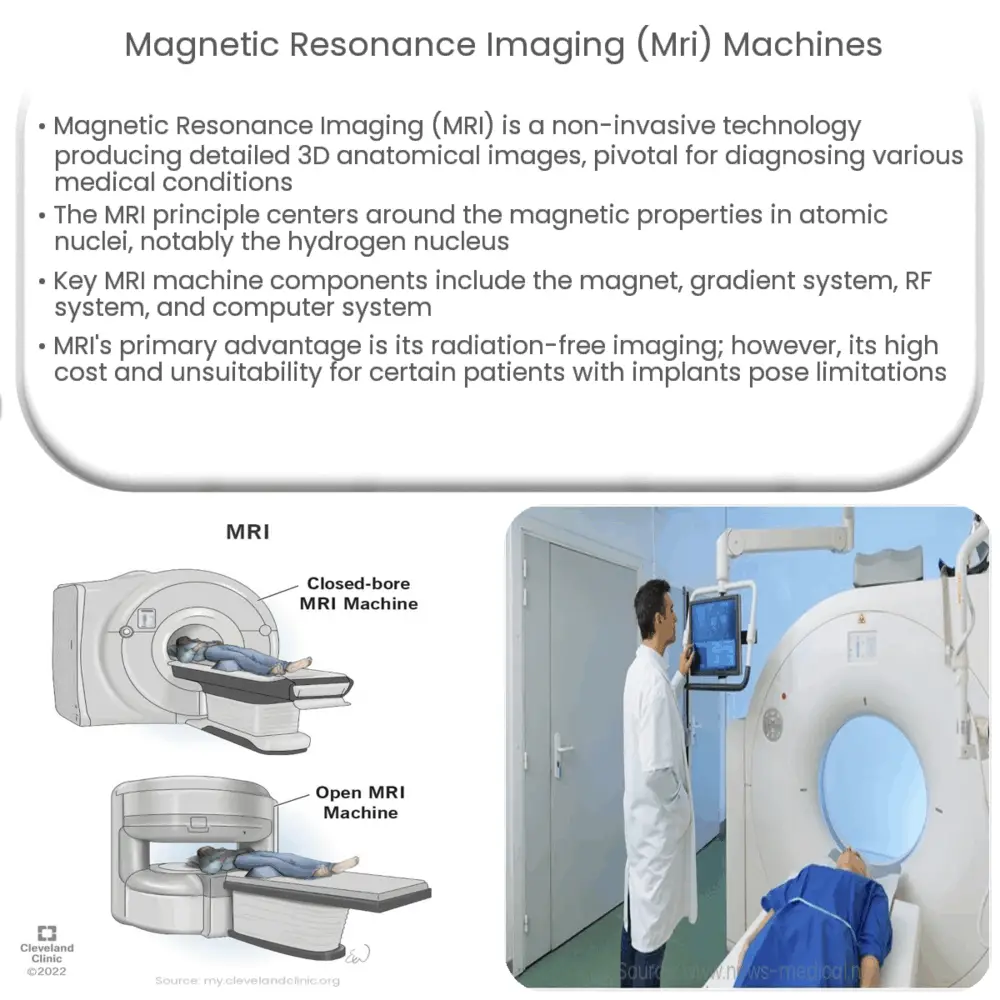Explore the world of Magnetic Resonance Imaging (MRI) machines, their function, components, uses, advantages, and future advancements.

Understanding Magnetic Resonance Imaging (MRI) Machines
Magnetic Resonance Imaging (MRI) is a non-invasive imaging technology that produces three-dimensional detailed anatomical images. It’s incredibly useful in the medical field and is often used to diagnose and monitor a variety of medical conditions.
The Science Behind MRI Machines
The principle behind MRI is based on the natural magnetic properties present in various atomic nuclei. The most commonly used nucleus in MRI is the hydrogen nucleus, which is abundant in water and fat in the body. When subjected to a strong magnetic field, these nuclei align with it, creating a net magnetization vector.
When an external radio frequency (RF) pulse is applied, the magnetization vector is disturbed from its equilibrium position. After the RF pulse is turned off, the vector recovers to its original state, a process known as relaxation. The signals obtained during relaxation are what create the MRI image.
Components of an MRI Machine
- Magnet: This is the most prominent part of the MRI machine. It produces a strong magnetic field that aligns the hydrogen protons in the body.
- Gradient system: It helps to further modify the main magnetic field, enabling the localization of the MRI signal from different parts of the body.
- RF system: It perturbs the equilibrium state of the magnetization vector. Once the RF pulse is turned off, the vector returns to its equilibrium state, and the RF system picks up the signals generated during this relaxation process.
- Computer system: The computer system processes the signals received from the RF system and constructs the MRI images.
Uses of MRI Machines
Due to their ability to produce detailed images of the body, MRI machines are widely used in medical diagnostics. They are particularly effective in imaging the non-bony parts or soft tissues of the body. From brain tumors to spinal cord injuries, from knee injuries to heart disease, MRI is a crucial tool in the diagnosis and monitoring of a wide array of medical conditions.
Advantages and Limitations of MRI
One major advantage of MRI is that it doesn’t use ionizing radiation, unlike X-rays and CT scans. This makes it a safer choice for imaging, particularly for patients who require multiple scans. However, due to the strong magnetic field, MRI isn’t suitable for patients with certain types of implants. Additionally, the cost of MRI scans can be a limiting factor for many patients.
The MRI Procedure
An MRI scan is a relatively straightforward procedure, although it can take some time. Patients lie on a table that slides into the MRI machine, which is essentially a large tube. They are asked to remain very still, as movement can blur the images. The radiologist and technologist operate the machine from a separate room, where they can communicate with the patient via an intercom. The procedure is painless, but the machine can be quite noisy due to the vibrations of the electrical coils.
MRI Safety
Although MRI is a safe procedure for most patients, certain precautions must be taken due to the strong magnetic field. Patients with metal implants, such as pacemakers, cochlear implants, certain types of vascular clips, or metal fragments in their eyes, may not be able to undergo an MRI. Furthermore, the closed nature of traditional MRI machines can cause discomfort or claustrophobia in some patients. However, open MRI machines are available for these patients.
The Future of MRI Technology
Since its invention, MRI technology has evolved significantly and continues to do so. Developments in scanner technologies, such as increasing the magnetic field strength and improving gradient systems, have improved the resolution and speed of MRI scans. Furthermore, advances in software are enabling the generation of new types of images and the automated analysis of MRI data. These improvements have the potential to further enhance the value of MRI in medical diagnosis and treatment planning.
Conclusion
In conclusion, Magnetic Resonance Imaging (MRI) machines are an essential part of modern medicine. They provide detailed images of the body’s interior without the use of ionizing radiation, making them a safe and effective diagnostic tool. While the technology has some limitations, such as being unsuitable for patients with certain metal implants and being potentially uncomfortable for those with claustrophobia, ongoing advancements in both hardware and software promise to overcome these challenges and extend the reach of MRI in the medical field. As we continue to refine and innovate this technology, the future of MRI holds immense potential.


